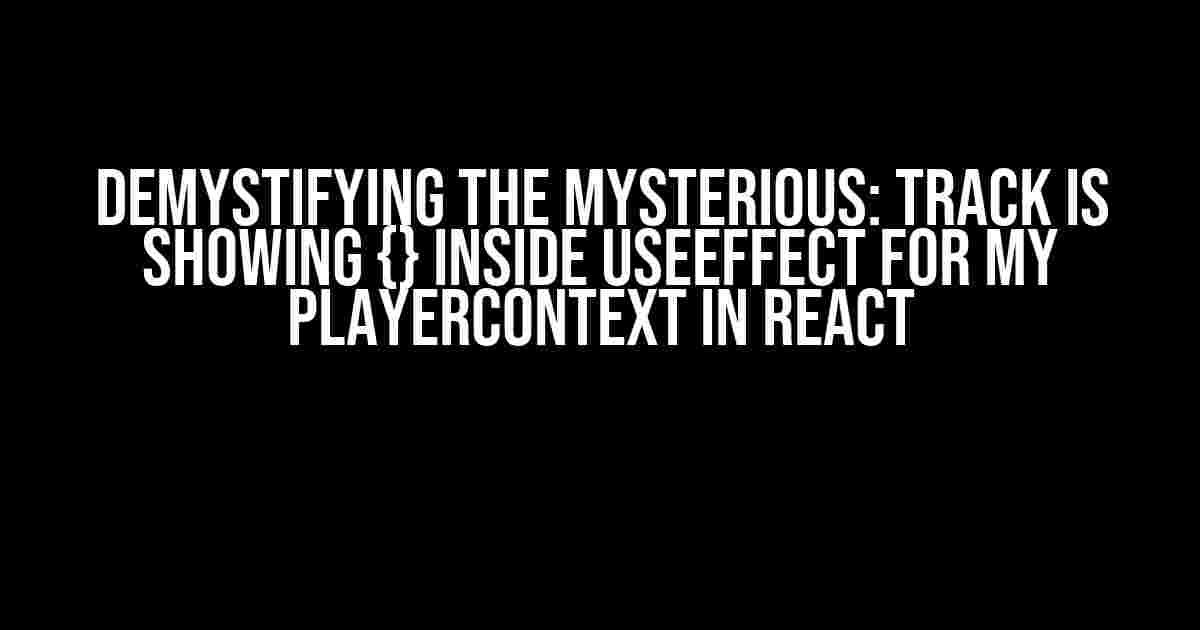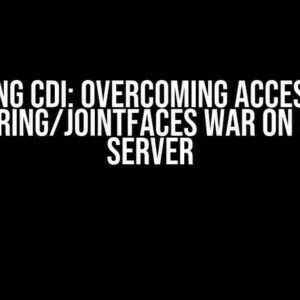Have you ever encountered the infuriating issue of “Track is showing {} inside useEffect for my PlayerContext in React”? Yeah, we’ve all been there. It’s like React is playing a cruel joke on us, leaving us wondering what on earth is going on. Fear not, dear reader, for today we’ll embark on a thrilling adventure to unravel the mysteries of this enigmatic error.
What is PlayerContext in React?
Before we dive into the nitty-gritty of the issue, let’s take a step back and understand what PlayerContext is in React. In simple terms, a context in React is a way to share data between components without passing props down manually. Think of it as a global store that components can access and update.
In the context (pun intended) of a music player, a PlayerContext might store information like the current track, playback status, and volume. This context can then be used by various components, such as the playlist, playback controls, and volume slider, to stay in sync and provide a seamless user experience.
The useEffect Hook and Its Woes
Now that we have a solid understanding of contexts, let’s move on to the useEffect hook. useEffect is a powerful tool in React that allows components to perform side effects, such as fetching data, setting timers, and updating the DOM. It’s like a special sauce that adds flavor to our React applications.
However, useEffect can also be a source of frustration, especially when paired with contexts. One common issue that arises is when the context is showing an empty object `{}` inside the useEffect hook. This can occur when the context is not properly initialized or when there’s a mismatch between the context’s value and the component’s props.
Common Causes of the Issue
Before we dive into the solutions, let’s identify some common causes of this issue:
useEffectis called before the context is initialized- The context’s value is not properly updated
- The component is not re-rendered after the context’s value changes
- The context’s value is not correctly passed as a prop to the component
Solving the Puzzle: Step-by-Step Guide
Now that we’ve identified the potential causes, let’s walk through a step-by-step guide to resolve the issue:
Step 1: Verify Context Initialization
First and foremost, ensure that the context is properly initialized before the component mounts. You can do this by creating a separate file for your context and initializing it using the createContext hook:
import { createContext, useState } from 'react';
const PlayerContext = createContext();
const PlayerProvider = ({ children }) => {
const [track, setTrack] = useState(null);
return (
<PlayerContext.Provider value={{ track, setTrack }}>
{children}
</PlayerContext.Provider>
);
};
export { PlayerProvider, PlayerContext };
Step 2: Update Context Value Correctly
Next, ensure that the context’s value is updated correctly when the track changes. You can do this by using the useState hook to update the track state and then passing it to the context provider:
import { useState, useContext } from 'react';
import { PlayerProvider, PlayerContext } from './PlayerContext';
const MyComponent = () => {
const [track, setTrack] = useState(null);
const { track: currentTrack } = useContext(PlayerContext);
useEffect(() => {
if (currentTrack !== track) {
setTrack(currentTrack);
}
}, [currentTrack]);
return (
<PlayerProvider>
<div>
<p>Current track: {track}</p>
</div>
</PlayerProvider>
);
};
Step 3: Re-render Component on Context Change
In this step, ensure that the component re-renders when the context’s value changes. You can do this by using the useContext hook to access the context’s value and then re-render the component when it changes:
import { useContext, useEffect } from 'react';
import { PlayerProvider, PlayerContext } from './PlayerContext';
const MyComponent = () => {
const { track } = useContext(PlayerContext);
useEffect(() => {
// Re-render component when track changes
}, [track]);
return (
<div>
<p>Current track: {track}</p>
</div>
);
};
Step 4: Pass Context Value as a Prop
Finally, ensure that the context’s value is passed as a prop to the component. You can do this by using the Context.Consumer component to access the context’s value and then pass it as a prop:
import { Context } from 'react';
import { PlayerProvider, PlayerContext } from './PlayerContext';
const MyComponent = ({ track }) => {
return (
<div>
<p>Current track: {track}</p>
</div>
);
};
const App = () => {
return (
<PlayerProvider>
<PlayerContext.Consumer>
{(context) => (
<MyComponent track={context.track} />
)}
</PlayerContext.Consumer>
</PlayerProvider>
);
};
Conclusion
And there you have it, folks! By following these steps, you should be able to resolve the issue of “Track is showing {} inside useEffect for my PlayerContext in React”. Remember to:
- Verify context initialization
- Update context value correctly
- Re-render component on context change
- Pass context value as a prop
By mastering these concepts, you’ll be well on your way to creating robust and maintainable React applications that delight your users.
Common Pitfalls to Avoid
As a bonus, here are some common pitfalls to avoid when working with contexts and useEffect:
- Avoid using
useStateanduseContextin the same component - Don’t forget to add the context provider to the component tree
- Make sure to update the context’s value correctly
- Use the correct import statement for the context and provider
Final Thoughts
In conclusion, the “Track is showing {} inside useEffect for my PlayerContext in React” issue is a common problem that can be resolved by following a step-by-step approach. By understanding the nuances of contexts and useEffect, you’ll be better equipped to tackle complex issues and create amazing React applications.
Remember, practice makes perfect. So, go ahead and build that music player app, and don’t let the “Track is showing {}” issue get in your way!
| Keyword | Description |
|---|---|
| PlayerContext | A context in React used to share data between components |
| useEffect | A hook in React used to perform side effects |
Happy coding!
Here are 5 Questions and Answers about “Track is showing {} inside useEffect for my PlayerContext in React”:
Frequently Asked Questions
Got stuck with an empty object showing up in your useEffect hook for PlayerContext in React? Fear not, dear developer! We’ve got you covered.
Why is my PlayerContext showing an empty object {} inside useEffect?
This is because the context value is not yet available when the useEffect hook is executed. The context value is only available after the component has rendered, and useEffect runs before the component has a chance to render. To fix this, you can add a conditional statement to check if the context value is available before using it.
How can I access the PlayerContext value inside useEffect?
You can access the PlayerContext value inside useEffect by using the `useContext` hook. Import the `useContext` hook from the `react` library, and then use it to get the context value. For example: `const playerContext = useContext(PlayerContext);`.
Why is my useEffect hook running infinitely when I try to update the PlayerContext?
This is because you’re updating the context value inside the useEffect hook, which causes the hook to re-run, and so on. To fix this, you can add a dependency array to the useEffect hook to specify when it should re-run. For example: `useEffect(() => { /* update context value */ }, [dependency]);`.
Can I use useState to update the PlayerContext value?
No, you should not use `useState` to update the PlayerContext value. The `useState` hook is used to manage local state, whereas the PlayerContext value is a global state managed by the context API. Instead, use the `useContext` hook to get the context value and then update it using the context API.
How can I debug the PlayerContext value inside useEffect?
You can debug the PlayerContext value inside useEffect by using the `console.log` function or a debugging tool like React DevTools. Simply log the context value to the console: `console.log(playerContext);` or use React DevTools to inspect the context value.



